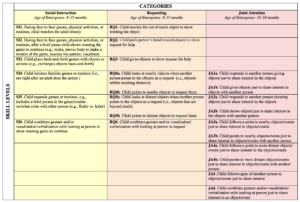
ASAP Manuals
- ASAP Manual I – Assessment and Intervention – Provides an overview of ASAP, the assessments used to determine a child’s skills and goals, and an explanation of the interventions.
- ASAP Manual II – Intervention Activities and Other Resources – Provides suggested activities and supplemental resources for working on ASAP goals at school.
- ASAP Manual III – Parent Handbook – Parent handbook, designed to help parents understand the intervention and support it at home.

Description: This occurs when the child points to a distant object to indicate that s/he wants the object Distant is defined as being out of reach. Pointing to distant object as a form or requesting shows that the child is growing in his/her understanding that another person can help him/her to get a desired item, and s/he can communicate his/her desires by pointing. Also, the child is furthering his/her understanding that pointing can reference objects that are farther away.
The hierarchies of social communication visually represent the order in which these skills develop, and the corresponding ASAP goals and objectives to help children build each level of communication and play.

When one person purposefully coordinates his or her focus of attention with that of another person, we refer to the behavior as “joint attention.” Joint attention involves two people paying attention to the same thing, intentionally and for social reasons. Imagine, for example, that a teacher points to her desk and says to a child, “Look at that big apple.” The child looks at the place the teacher has pointed and sees the apple. In this situation, the teacher and the child have engaged in joint attention—that is, they shared attention to the apple on purpose.